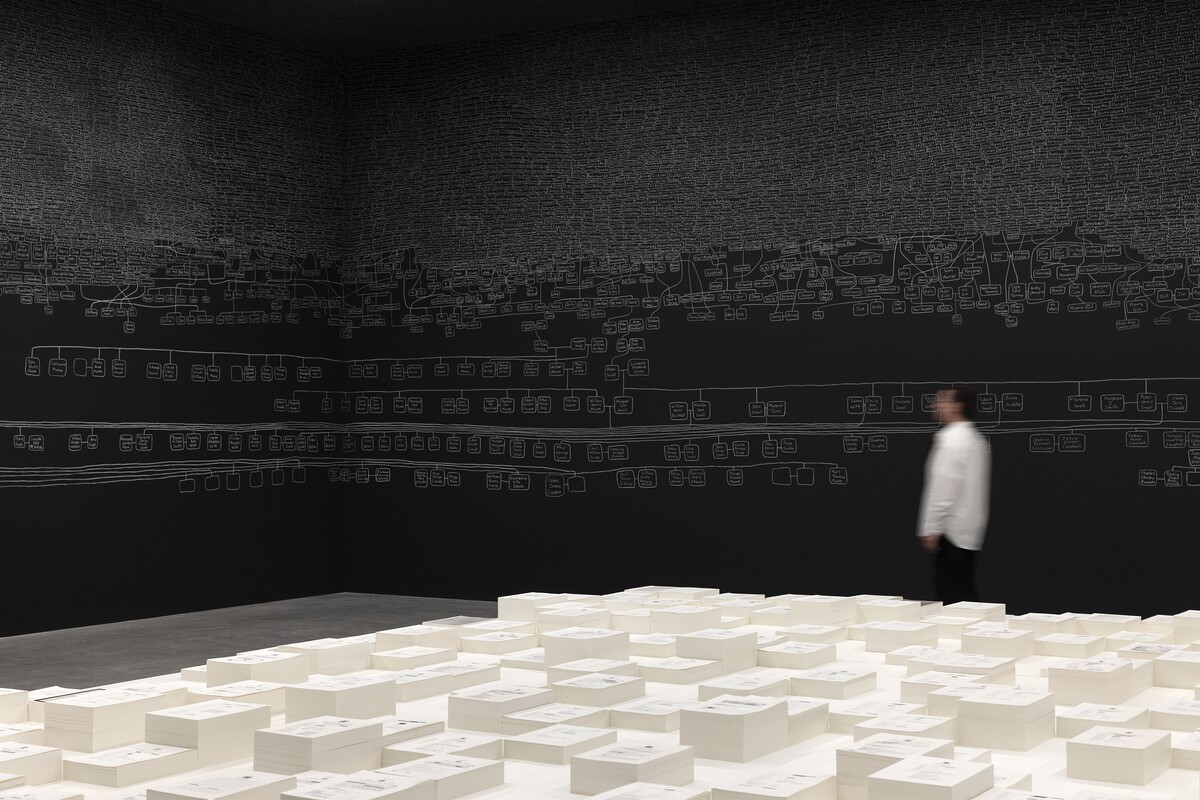kith and kin
April 20–November 24, 2024
Giardini di Castello
Venice
Italy
kith and kin; an enveloping artwork created in situ by First Nations artist Archie Moore, premieres at the Australia Pavilion at the 60th Venice Biennale. Commissioned by Creative Australia and curated by Ellie Buttrose.
“kith and kin is a memorial dedicated to every living thing that has ever lived, it is a space for quiet reflection on the past, the present and the future.” —Archie Moore
Moore transforms the Australia Pavilion with an expansive, genealogical chart spanning 65,000+ years. Drawing on his Kamilaroi, Bigambul, British and Scottish heritage, the installation embodies Moore’s enduring exploration of history and identity. His work brings international awareness to the vitality of First Nations kinship and sovereignty, in spite of facing systemic injustices since British invasion in 1770.
Hand-drawn in white chalk, the family tree unfolds across the Pavilion’s black walls and ceiling, illustrating Moore’s lineage stretching back more than 2,400 generations. Derived from the artist’s research with family, community and archivists, this intricate map of relations reflects the unique familial structures of First Nations Australians that includes all living things and affirms their status as some of the longest-continuous living cultures in the world. Extending across the ceiling, the inscribed names resemble a celestial map; evoking the ancestors’ resting place. In the First Nations Australian understanding of time; the past, present and future are co-present. By placing tens of thousands of years of kin on a single continuum, Moore makes this notion visible to audiences.
The chart is also a stark representation of the decline in First Nations Australian languages and dialects under colonisation. Countering this, Moore enacts language maintenance through his use of Gamilaraay (the Kamilaroi nation’s language) and Bigambul kinship terms. kith and kin illustrates the shift from Indigenous to European languages, the translation of oral languages to written text, and the introduction of racial categories and slurs. Moments of erasure amidst the names represent the atrocities inflicted upon First Nations communities, such as massacres, the introduction of diseases and destruction of knowledge that have all produced intergenerational trauma. Moore’s choice of educational materials—fragile chalk on blackboard—addresses the insufficient dissemination of First Nations histories.
The central memorial pool pays tribute to the injustices still faced by First Nations peoples today. Suspended above it are hundreds of document stacks containing coronial inquests on the deaths of Indigenous Australians in police custody dated in our lifetime. First Nations Australians are one of the most incarcerated people globally. Surrounded by the limitless family tree, viewers are reminded that the reports do not represent nameless statistics; rather, they are children, siblings, cousins, parents, and grandparents.
Moore’s artwork bridges the personal and the political. Amid the contemporary coroners’ reports are historic documents with specific references to the artist’s family. These bureaucratic papers evidence how pernicious laws and government policies have long been imposed upon First Nations peoples, emphasising the connection between the current incarceration epidemic and historic injustices. While many of the stories in kith and kin are specific to the artist’s family, they mirror narratives throughout the world. Through this lens Moore highlights our shared ancestry and humanity: through the interconnectedness of people, place and time.
On Thursday, April 18 at Fondazione Querini Stampalia, a series of conversations will reflect upon art’s role in abolition movements and First Nations language maintenance, presented by Creative Australia in partnership with ArtReview and Fondazione Querini Stampalia. “In discussion with kith and kin” features: Archie Moore, Arissana Pataxó, Daniel Browning, Denilson Baniwa, Djon Mundine OAM, Ellie Buttrose, Gustavo Caboco Wapichana, Gülsün Karamustafa, Hank Willis Thomas, heather ahtone, and Lorena Allam.
Co-published by Creative Australia and Spector Books, the book features essays by the artist, Djon Mundine, Ellie Buttrose, Larissa Behrendt OA, Macarena Gómez-Barris, Melissa Lucashenko, and roundtable discussion with Archie Moore, Felicity Meakins, Diane Bell, Grace Lucas-Pennington and Raymond Kelly. The exhibition website hosts videos of the artist, Djon Mundine, Ellie Buttrose, Franchesca Cubillo, Larissa Behrendt, Stephanie Rosenthal, and Tina Baum discussing the exhibition and Moore’s wider practice.
kith and kin is developed with Grace Lucas-Pennington, editor; Kevin O’Brien, exhibition design consultant; Sebastian Adams, exhibition digital designer; and Stuart Geddes and Žiga Testen, graphic design work.
Read more at kithandkin.me or visit the Creative Australia website.
For international media enquiries, please contact: Rel Hayman, Pelham Communications, T +44 (0)20 8969 3959 / rel [at] pelhamcommunications.com
For media enquiries within Australia and New Zealand, please contact: Claire Martin, ARTICULATE, T +61 (0) 414 437 588 / claire [at] articulatepr.com.au



